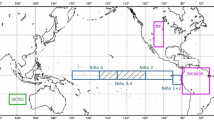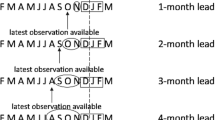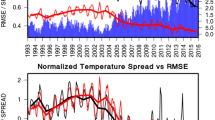Abstract
Currently, ensemble seasonal forecasts using a single model with multiple perturbed initial conditions generally suffer from an “overconfidence” problem, i.e., the ensemble evolves such that the spread among members is small, compared to the magnitude of the mean error. This has motivated the use of a multi-model ensemble (MME), a technique that aims at sampling the structural uncertainty in the forecasting system. Here we investigate how the structural uncertainty in the ocean initial conditions impacts the reliability in seasonal forecasts, by using a new ensemble generation method to be referred to as the multiple-ocean analysis ensemble (MAE) initialization. In the MAE method, multiple ocean analyses are used to build an ensemble of ocean initial states, thus sampling structural uncertainties in oceanic initial conditions (OIC) originating from errors in the ocean model, the forcing flux, and the measurements, especially in areas and times of insufficient observations, as well as from the dependence on data assimilation methods. The merit of MAE initialization is demonstrated by the improved El Niño and the Southern Oscillation (ENSO) forecasting reliability. In particular, compared with the atmospheric perturbation or lagged ensemble approaches, the MAE initialization more effectively enhances ensemble dispersion in ENSO forecasting. A quantitative probabilistic measure of reliability also indicates that the MAE method performs better in forecasting all three (warm, neutral and cold) categories of ENSO events. In addition to improving seasonal forecasts, the MAE strategy may be used to identify the characteristics of the current structural uncertainty and as guidance for improving the observational network and assimilation strategy. Moreover, although the MAE method is not expected to totally correct the overconfidence of seasonal forecasts, our results demonstrate that OIC uncertainty is one of the major sources of forecast overconfidence, and suggest that the MAE is an essential component of an MME system.




Similar content being viewed by others
References
Balmaseda M, Vidard A, Anderson D (2008) The ECMWF System 3 ocean analysis system. Mon. Wea. Rev. 136:3018–3034
Balmaseda M, Mogensen K, Molteni F, Weaver A (2010) The NEMOVAR-COMBINE ocean re-analysis. COMBINE technical report No. 1. p. 10 http://www.combine-project.eu/Technical-Reports.1668.0.html
Balmaseda M, Mogensen K, Weaver A (2013) Evaluation of the ECMWF ocean reanalysis ORAS4. Quart. J. Roy. Meteor. Soc. doi:10.1002/qj.2063
Behringer DW (2005) The global ocean data assimilation system (GODAS) at NCEP, 11th symposium on integrated observing and assimilation systems for the atmosphere, oceans, and land surface (IOAS-AOLS), San Antonio, TX, American Meteorological Society, 3.3
Corti S, Weisheimer A, Palmer TN, Doblas-Reyes FJ, Magnusson L (2012) Reliability of decadal predictions. Geophys Res Lett 39:L21712
Griffies SM, Harrison MJ, Pacanowski RC, Rosati A (2004) Technical guide to MOM4, GFDL ocean group technical report no. 5. NOAA/Geophysical Fluid Dynamics Laboratory. Available on-line at. http://www.gfdl.noaa.gov/*fms
Jin EK et al (2008) Current status of ENSO prediction skill in coupled ocean-atmosphere models. Clim Dyn 31:647–664
Johnson C, Bowler N (2009) On the reliability and calibration of ensemble forecasts. Mon. Wea. Rev. 137:1717–1720
Kirtman BP, Min D (2009) Multimodel Ensemble ENSO Prediction with CCSM and CFS. Mon. Wea. Rev. 137:2908–2930
Kug J-S, Ham Y-G, Kimoto M, Jin F-F, Kang I-S (2010) New approach on the optimal perturbation method for ensemble climate prediction. Clim Dyn. doi:10.1007/s00382-009-0664-y
Kug J-S, Ham Y-G, Lee EJ, Kang IS (2011) Empirical singular vector method for ensemble El Niño–Southern Oscillation prediction with a coupled general circulation model. J Geophys Res 116:C08029
Langford S, Hendon HH (2013) Improving Reliability of Coupled Model Forecasts of Australian Seasonal Rainfall. Mon. Wea. Rev. 141:728–741
Latif M, Anderson D, Barnett T, Cane M, Kleeman R, Leetmaa A, O’Brien J, Rosati A, Schneider E (1998) A review of the predictability and prediction of ENSO. J Geophys Res 103:14375–14393. doi:10.1029/97JC03413
Magnusson L, Balmaseda M, Corti S, Molteni F, Stockdale T (2012) Evaluation of forecast strategies for seasonal and decadal forecasts in presence of systematic model errors. Clim Dyn. doi:10.1007/s00382-012-1599-2
Manganello JV, Huang B (2009) The influence of systematic errors in the Southeast Pacific on ENSO variability and prediction in a coupled GCM. Clim Dyn 32:1015–1034. doi:10.1007/s00382-008-0407-5
Molteni F, Stockdale T, Balmaseda M, Balsamo G, Buizza R, Ferranti L, Magnusson L, Mogensen K, Palmer T, Vitart F (2011) The new ECMWF seasonal forecast system (System 4). ECMWF Technical Memorandum No. 656, p. 49
Palmer TN, Buizza R, Molteni E, Chen Y-Q, Corti S (1994) Singular vectors and the predictability of weather and climate. Philos Trans R Soc Lond 348:459–475
Palmer TN et al (2004) Development of a European Multimodel Ensemble System for Seasonal-to-Interannual Prediction (DEMETER). Bull. Amer. Meteor. Soc. 85:853–872
Pan X, Huang B, Shukla J (2011) The influence of mean climate on the equatorial Pacific seasonal cycle and ENSO: simulation and prediction experiments using CCSM3. Clim Dyn 37:325–341. doi:10.1007/s00382-010-0923-y
Peng P, Kumar A, Halpert MS, Barnston AG (2012) An analysis of CPC’s operational 0.5-month lead seasonal outlooks. Wea Forecasting 27:898–917
Reynolds RW, Rayner NA, Smith TM, Stokes DC, Wang W (2002) An improved in situ and satellite SST analysis for climate. J. Climate 15:1609–1625
Saha S et al (2006) The NCEP Climate Forecast System. J. Climate 19:3483–3517
Saha S et al (2010) The NCEP climate forecast system reanalysis. Bull. Amer. Meteor. Soc. 91:1015–1057
Saha S et al (2013) The NCEP Climate Forecast System Version 2. Submitted to J, Climate
Schneider EK, Huang B, Zhu Z, DeWitt DG, Kinter JL III, Kirtman B, Shukla J (1999) Ocean data assimilation, initialization, and predictions of ENSO with a coupled GCM. Mon. Wea. Rev. 127:1187–1207
Toth Z, Kalnay E (1997) Ensemble Forecasting at NCEP: the breeding method. Mon. Wea. Rev. 125:3297–3319
Vialard J, Vitart F, Balmaseda MA, Stockdale TN, Anderson DLT (2005) An ensemble generation method for seasonal forecasting with an ocean-tmosphere coupled model. Mon. Wea. Rev. 133:441–453
Wang W, Chen M, Kumar A (2010) An assessment of the CFS real-time seasonal forecasts. Wea. Forecasting 25:950–969. doi:10.1175/2010WAF2222345.1
Wang W, Chen M, Kumar A, Xue Y (2011) How important is intraseasonal surface wind variability to real-time ENSO prediction? Geophys Res Lett 38:L13705. doi:10.1029/2011GL047684
Weigel AP, Liniger MA, Appenzeller C (2009) Seasonal ensemble forecasts: Are re-calibrated single models better than multimodels? Mon. Wea. Rev. 137:1460–1479
Weisheimer A et al (2009) ENSEMBLES: A new multi-model ensemble for seasonal-to-annual predictions—Skill and progress beyond DEMETER in forecasting tropical Pacific SSTs. Geophys Res Lett 36:L21711. doi:10.1029/2009GL040896
Wen C, Xue Y, Kumar A (2012) Ocean-Atmosphere Characteristics of Tropical Instability Waves Simulated in the NCEP Climate Forecast System Reanalysis. J. Climate 25:6409–6425
Wilks DS (2006) Statistical methods in the atmospheric sciences, 2nd edn. International Geophysics Series, vol 59. Academic Press, New York, p 627
Xue Y et al (2012) A Comparative Analysis of Upper Ocean Heat Content Variability from an Ensemble of Operational Ocean Reanalyses. J. Climate 25:6905–6929. doi:10.1175/JCLI-D-11-00542.1
Yang S-C, Kalnay E, Cai M, Rienecker MM (2008) Bred vectors and tropical pacific forecast errors in the NASA coupled general circulation model. Mon Wea. Rev. 136:1305–1326
Zhang R-H, Busalacchi AJ (2008) Rectified effects of tropical instability wave (TIW)-induced atmospheric wind feedback in the tropical Pacific. Geophys Res Lett 35:L05608. doi:10.1029/2007GL033028
Zhu J, Huang B, Balmaseda MA (2012a) An Ensemble Estimation of the Variability of Upper-ocean Heat Content over the Tropical Atlantic Ocean with Multi-Ocean Reanalysis Products. Clim Dyn 39:1001–1020. doi:10.1007/s00382-011-1189-8
Zhu J, Huang B, Marx L, Kinter JL III, Balmaseda MA, Zhang R-H, Hu Z-Z (2012b) Ensemble ENSO hindcasts initialized from multiple ocean analyses. Geophys Res Lett 39. doi:10.1029/2012GL051503
Zhu J, Huang B, Hu Z-Z, Kinter JL III, Marx L (2013) Predicting U.S. Summer Precipitation using NCEP Climate Forecast System Version 2 initialized by Multiple Ocean Analyses. Clim Dyn. doi:10.1007/s00382-013-1785-x
Acknowledgements
Funding for this study was provided by grants from NSF (ATM-0830068), NOAA (NA09OAR4310058), and NASA (NNX09AN50G). The authors would like to thank Dr. J. Shukla for his guidance and support of this project. We thank ECMWF and NCEP for providing their ocean data assimilation analysis datasets, which made this project possible. The authors gratefully acknowledge NCEP for the CFSv2 model made available to COLA. Computing resources provided by NAS are also gratefully acknowledged.
Author information
Authors and Affiliations
Corresponding author
Additional information
This paper is a contribution to the Topical Collection on Climate Forecast System Version 2 (CFSv2). CFSv2 is a coupled global climate model and was implemented by National Centers for Environmental Prediction (NCEP) in seasonal forecasting operations in March 2011. This Topical Collection is coordinated by Jin Huang, Arun Kumar, Jim Kinter and Annarita Mariotti.
Appendix
Appendix
1.1 Four ocean analyses used in hindcast AP/MAE
In hindcast MAE, four different ocean analyses were used as OICs, with two from ECMWF and two from NCEP. They are the ECMWF COMBINE-NV (Balmaseda et al. 2010), the ECMWF Ocean Reanalysis System 3 (ORA-S3; Balmaseda et al. 2008), the NCEP Climate Forecast System Reanalysis (CFSR; Saha et al. 2010), and the NCEP Global Ocean Data Assimilation System (GODAS; Behringer 2005). The GODAS and CFSR (ORA-S3) ocean analyses have been used to initialize the operational seasonal predictions made by NCEP (ECMWF). COMBINE-NV, which is only slightly different from ECMWF Ocean Reanalysis System 4 (ORA-S4), has been used to initialize their decadal predictions at ECMWF. Table 1 briefly summarizes the major characteristics of these ocean analyses, including the models, resolutions, assimilation methods, and the assimilated data. To show the systematic differences among the four ocean analyses, Figs. 5 and 6 present the standard deviation of SST/HC300 systematic differences among them and the signal versus noise ratio maps, respectively. From Fig. 5, it can be seen that SST shows little difference among them in the tropics expect for the far eastern coastal regions. There is larger difference among them in the subsurface as shown in Fig. 5b. Particularly, in the off-equatorial regions the difference in HC300 is larger than 0.2 °C, with less difference along the equator. Figure 6 also indicates that SSTs have relatively lower level of noises, while HC300s have larger level of noises, particularly over the off-equatorial regions.
The standard deviation of the systematic differences in a SST and b the upper 300 m mean ocean temperature (HC300) for 1982–2007 among the four ocean analyses used in the study (i.e., COMBINE-NV, ORA-S3, CFSR, GODAS). Contours 0.2, 0.4, 0.6, 1, 15 are shown. The systematic differences are calculated as the difference between four individual datasets and their ensemble mean. Unit: °C
The global maps of the signal versus noise ratio of a SST and b HC300 for 1982–2007 derived from the four ocean analyses (i.e., COMBINE-NV, ORA-S3, CFSR, GODAS). Contours 1, 2, 5, 10, 15 are shown. Here signal is defined as the interannual variance in the ensemble mean of four datasets; noise is defined as the variance of the difference between four individual datasets and their ensemble mean
1.2 Experimental design for hindcast AP/MAE
For hindcast AP_cbn, AP_ora3, AP_cfsr, and AP_gds, the atmosphere, land and sea ice initial states are specified in the same way, using the instantaneous fields from the CFSR. For each hindcast, four ensemble members are generated that differ in their atmosphere/land surface conditions, which are the instantaneous fields from 00Z of the first four days in April in the CFSR, respectively. For the OIC, to reduce the potentially negative effects of the mean biases in ocean analyses and the forecast model, and to make the predictions using OIC from different analyses comparable, we applied an anomaly ocean initialization strategy (e.g., Schneider et al. 1999) in these experiments. For this purpose, a monthly climatology for the CFSv2 ocean component was derived from the last 20 years of a 30-year simulation starting from CFSR state on November 1, 1980. The monthly anomalies of all variables from the ocean analyses are then calculated with respect to their own climatologies and superimposed on the CFSv2 monthly climatological states. The fields in March and April are averaged to represent the oceanic states at the start of April. Initializing the hindcasts using the monthly oceanic analyses is different from the operational practice of using an instantaneous analysis from the ocean data assimilation system. A set of test runs in Zhu et al. (2012b) showed that using the monthly fields as OIC has little impact on the deterministic forecasting skill (see Fig. S1 of the auxiliary material in Zhu et al. (2012b)).
Rights and permissions
About this article
Cite this article
Zhu, J., Huang, B., Balmaseda, M.A. et al. Improved reliability of ENSO hindcasts with multi-ocean analyses ensemble initialization. Clim Dyn 41, 2785–2795 (2013). https://doi.org/10.1007/s00382-013-1965-8
Received:
Accepted:
Published:
Issue Date:
DOI: https://doi.org/10.1007/s00382-013-1965-8






